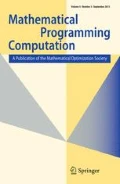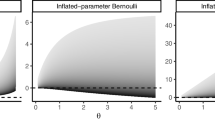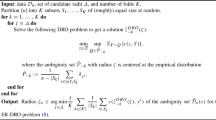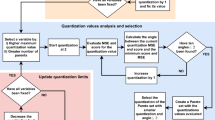Abstract
This paper studies a statistical problem called instrumental variable quantile regression (IVQR). We model IVQR as a convex quadratic program with complementarity constraints and—although this type of program is generally NP-hard—we develop a branch-and-bound algorithm to solve it globally. We also derive bounds on key variables in the problem, which are valid asymptotically for increasing sample size. We compare our method with two well known global solvers, one of which requires the computed bounds. On random instances, our algorithm performs well in terms of both speed and robustness.








Similar content being viewed by others
References
Ahuja, R.K., Orlin, J.B.: Inverse optimization. Oper. Res. 49(5), 771–783 (2001)
Audet, C., Savard, G., Zghal, W.: New branch-and-cut algorithm for bilevel linear programming. J. Optim. Theory Appl. 38(2), 353–370 (2007)
Bai, L., Mitchell, J.E., Pang, J.S.: On convex quadratic programs with linear complementarity constraints. Comput. Optim. Appl. 54(3), 517–554 (2013)
Belloni, A., Chen, D., Chernozhukov, V., Hansen, C.: Sparse models and methods for optimal instruments with an application to eminent domain. Econometrica 80(6), 2369–2429 (2012)
Cai, M.C., Duin, C.W., Yang, X.G., Zhang, J.Z.: The partial inverse minimum spanning tree problem when weight increase is forbidden. Eur. J. Oper. Res. 188(2), 23–28 (2008)
Chen, C.: An introduction to quantile regression and QUANTREG procedure. In: 30th SAS user group international conference. SAS institute INC, Philadelphia (2005)
Chernozhukov, V., Hansen, C.: Instrumental variable quantile regression: a robust inference approach. J. Econom. 142(1), 379–398 (2008)
Couenne, a solver for non-convex MINLP problems. Technical report, http://www.coin-or.org/Couenne/
Eckstein, J.: Parallel branch-and-bound algorithms for general mixed integer programming on the cm-5. SIAM J. Optim. 4, 794–814 (1994)
Forrest, J.J.H., Hirst, J.P.H., Tomlin, J.A.: Practical solution of large scale mixed integer programming problems with umpire. Manag. Sci. 20, 736–773 (1974)
Gabriel, S.A., Gareia-Bertrand, R., Sahakij, P., Concjo, A.J.: A practical approach to approximate bilinear functions in mathematical programming problems by using Schur’s decomposition and SOS type 2 variables. J. Oper. Res. Soc. 57(8), 995–1004 (2006)
Gentry, S.: Partial inverse linear programming. Technical Report LIDS-P-2532, Massachusetts Inst. Tech., Lab for Information and Decision Systems (2001)
Glankwamdee, W.: Topics in Branch and Bound on Computational Grids. ProQuest (2008)
Heuberger, C.: Inverse combinatorial optimization: a survey on problems, methods, and results. J. Comb. Optim. 8(3), 329–361 (2004)
Horowitz, J., Lee, S.: Nonparametric instrumental variables estimation of a quantile regression model. Econometrica 75(4), 1191–1208 (2007)
Hu, J., Mitchell, J.E., Pang, J.S., Bennett, K.P., Kunapuli, G.: On the global solution of linear programs with linear complementarity constraints. SIAM J. Optim. 19(1), 445–471 (2008)
Koenker, R., Hallock, K.F.: Quantile regression. J. Econ. Perspect. 15(4), 143–156 (2001)
Lai, T.C., Orlin, J.B.: The complexity of preprocessing. Technical report, Sloan School of Management, MIT (2003)
Lee, Y.C., Pang, J.S., Mitchell, J.E.: An algorithm for global solution to bi-parametric linear complementarity constrained linear programs. SIAM J. Optim. 62(2), 263–297 (2015)
Liu, G.S., Zhang, J.Z.: A new branch-and-bound algorithm for solving quadratic programs with linear complementarity constraints. J. Comput. Appl. Math. 146(1), 77–87 (2002)
Mangasarian, O.L.: Regularized linear programs with equilibrium constraints. In: Fukushima, M., Qi, L. (eds.) Reformulation-nonsmooth, piecewise smooth, semismooth and smoothing methods, pp. 259–268. Kluwer Academic Publisher, Dordrecht (1998)
Mitchell, J.E., Pang, J.S., Yu, B.: Obtaining tighter relaxations of mathematical programs with complementarity constraints. In Terlaky, T., Curtis, F. (eds) Modeling and Optimization: Theory and Applications, volume 21 of Springer Proceedings in Mathematics and Statistics, chapter 1. pp. 1–23. Springer, New York (2012)
Montgomery, D., Peck, E., Vining, G.: Introduction to Linear Regression Analysis. Wiley, New York (1982)
Sabo, K., Scitovski, R.: The best least absolute deviations line-properties and two efficient methods for its derivation. Anziam J. 50, 185–198 (2008)
Sherali, H.D., Alameddine, A.: A new reformulation—linearization technique for bilinear programming problems. J. Glob. Optim. 2(4), 379–410 (1992)
Vandenbussche, D., Nemhauser, G.: A polyhedral study of nonconvex quadratic programs with box constraints. Math. Program. 102(3), 531–557 (2005)
Wang, Q.: Partial inverse most unbalanced spanning tree problem. Przeglad Elektrotechniczny 88(1b), 111–114 (2012)
Yang, X.G.: Complexity of partial inverse assignment problem and partial inverse cut problem. RAIRO—Oper. Res. 35(1), 117–126 (2001)
Yang, X.G., Zhang, J.Z.: Inverse sorting problem by minimizing the total weighted number of changes and partial inverse sorting problems. Comput. Optim. Appl. 36(1), 55–66 (2007)
Yang, X.G., Zhang, J.Z.: Partial inverse assignment problems under \(l_1\) norm. Oper. Res. Lett. 35(1), 23–28 (2007)
Zhang, J., Liu, Z.: Calculating some inverse linear programming problems. J. Comput. Appl. Math. 72(2), 215–434 (1996)
Acknowledgements
The authors would like to acknowledge the participation and contribution of Alexandre Belloni, who supplied the IVQR problem as an interesting global, quadratic problem. He also provided the code to generate instances of the IVQR problem consistent with the statistics literature. The authors also express their sincere thanks to two anonymous referees and one anonymous technical editor for their helpful and insightful comments to improve the paper.
Author information
Authors and Affiliations
Corresponding author
Appendices
Appendix A Proof of Lemma 1
Proof
Since \(Ax^* + \epsilon = b\), we have from the triangle inequality that \(\Vert \epsilon \Vert _\infty \le \Vert b\Vert _\infty + \Vert Ax^* \Vert _\infty \) and \(\Vert Ax^*\Vert _\infty \le \Vert b\Vert _\infty + \Vert \epsilon \Vert _\infty \). So the event \(\Vert \epsilon \Vert _\infty > C \Vert b\Vert _\infty \) implies
and
which together imply
This proves the first bound. To prove the second, we note that, by definition,
and so \(\Vert \epsilon \Vert _\infty > C \Vert b\Vert _\infty \) implies that \(|\epsilon _i| > C \max _{k=1}^m |a_k^{\text {T}} x^* + \epsilon _k|\) holds for at least one specific i. Hence,
Next, we claim \(|a_k^{\text {T}} x^* + \epsilon _k| \ge |\epsilon _k| \cdot \mathbbm {1}\{\epsilon _k a_k^{\text {T}} x^* \ge 0 \}\) for each k. If \(\epsilon _k a_k^{\text {T}} x^* < 0\), this is certainly true. Otherwise, if \(\epsilon _ka_k^{\text {T}}x^* \ge 0\), then \(\epsilon _k\) and \(a_k^{\text {T}}x^*\) have the same (possibly zero) signs and hence \(|a_k^{\text {T}}x^* + \epsilon _k| \ge |\epsilon _k|\). Thus,
and so
Combining inequalities (14) and (15), we achieve the second bound. \(\square \)
Appendix B Proof of Lemma 2
Proof
The first two-sided inequality is a standard fact about the normal distribution. For the last inequality, we have
By the first part of the lemma and the standard fact that \(0< x < 1\) and \(a > 0\) imply \((1-x)^a \le \exp (-ax)\),
Now substituting the definition of \(\epsilon (\theta )\) and \(\theta = \sqrt{\log (q)}\), we see
where the last inequality follows from the assumption that \(q/(8\pi \log (q)) \ge \sqrt{q}\). This proves the result. \(\square \)
Rights and permissions
About this article
Cite this article
Xu, G., Burer, S. A branch-and-bound algorithm for instrumental variable quantile regression. Math. Prog. Comp. 9, 471–497 (2017). https://doi.org/10.1007/s12532-017-0117-2
Received:
Accepted:
Published:
Issue Date:
DOI: https://doi.org/10.1007/s12532-017-0117-2




